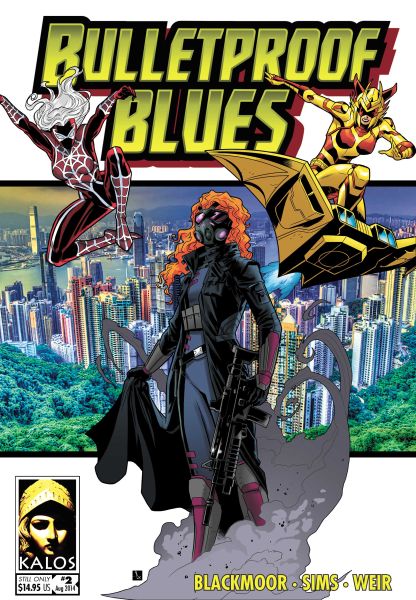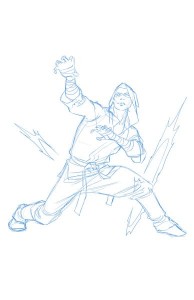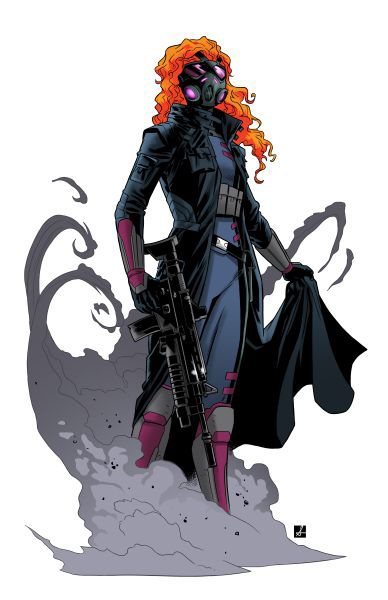Nick Ahlhelm invited Brandon Blackmoor to sit in on the SuperPowerCast. They discussed Bulletproof Blues Second Edition, Brandon’s history with superheroes, and how neither of them has seen Amazing Spider-Man 2 or X-Men: Days of Future Past yet.
Black Steel, The Hidden Blade
Here is the full colour version of Tommy Lee, also known as Black Steel, “The Hidden Blade”. Black Steel was the winning character in the GagMen RPG Podcast character contest.
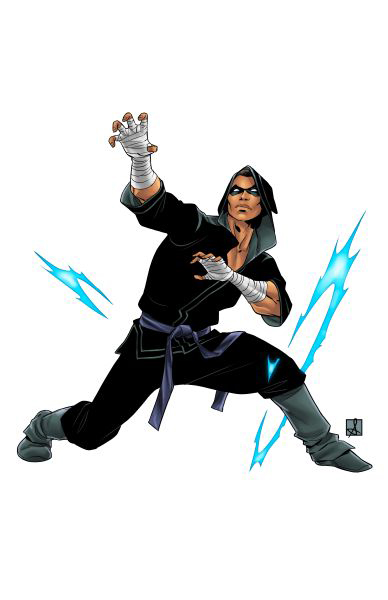
Tommy’s father was Korean, and his mother was an African-American US diplomat stationed in South Korea. His sculpted profile and green eyes gives him striking good looks, but his features are rounded enough to make him inviting rather than intimidating. He is always impeccably dressed when in his civilian identity; as Black Steel, he wears a black gi paired with a deep hood and a domino mask.
At the peak of human ability, even without his powers Tommy would be a deadly foe. But add in his ability to teleport, control kinetic energy, and mark targets, and you get an implacable hunter, able to reach targets where they think they are safest.
Tentative ZeroSpace logo 02
Inks: Black Steel
Here is the inked version of Black Steel, Kenji Ikiryo’s winning submission in the GagMen Podcast character contest.
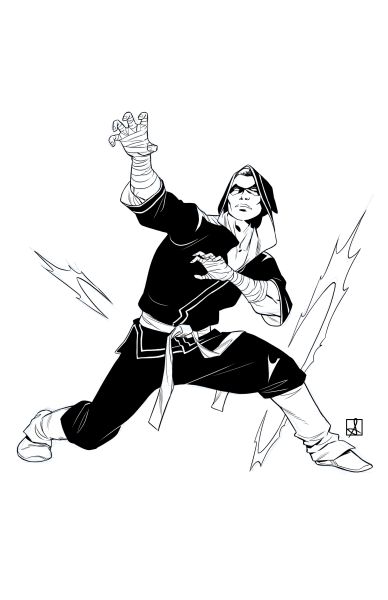
Tentative ZeroSpace logo 01
Sketch: Black Steel
Here is a sketch of the winner of our GagMen Podcast character contest: Tommy Lee, who calls himself Black Steel.
Current revisions to Order Of Play
After some discussion and feedback, both privately and over on the Kalos Comics Community page on Google+, we have made the following changes to the Order Of Play section for Bulletproof Blues second edition. Knock on wood, this is very close to what will appear in the published book.
Order Of Play
Everything that happens in a round is assumed to occur more or less simultaneously, but the players can’t all speak at once. To keep the game orderly, we need a way to determine the order in which characters act when combat starts.
The most important factor in determining who acts before whom is situational awareness. If a character is not aware of their opponent, then they don’t have the opportunity to attack. For example, if a hero is lurking on a rooftop and observes a gang of hooligans breaking into an electronics store, there is no need to roll to see who goes first. The hooligans are unaware that there is anyone to fight, so they continue carrying boxes of loot out of the store. In the first round of combat, only the hero has the opportunity to act. Depending on what the hero does and how sneaky the hero is, it’s possible that the hero might be the only one with an opportunity to act for several rounds. Only after the hooligans become aware of the hero do they get the opportunity to act. At that point, the order of action in each round is the hero first, and then the hooligans. If the combatants become aware of their adversaries in a set order, then that is the order in which they act in combat — at least, until someone changes it.
Normally, characters take their actions in the same order that they have an opportunity to act. However, if the various combatants become aware of each other more or less simultaneously, or if you would prefer to roll dice to see who goes first, the players and the GM should each make a Perception task roll at the beginning of the scene. Turns proceed each round from the highest roller to lowest. If a character (or one of the non-player characters) has the Super-speed power, the player (or GM) gets a bonus to the Perception task roll equal to the rank in Super-speed (for example, rank 4 Super-speed would provide a +4 bonus to the Perception roll).
The environment always goes last in a round. Any falling objects (including characters) fall, and any free-rolling vehicles move, after all characters have had the opportunity to use their actions. This does not include thrown projectiles or character-controlled vehicles. If any object or vehicle is under direct control by a character, then the object or vehicle will move when that character moves it or at the end of the round, at the character’s option. If a character chooses not to control a vehicle, then the vehicle will move at the end of the round.
If your character starts the scene by going last, either because your character was caught unaware or because you rolled poorly at the beginning of the scene, don’t worry too much about it. The order of play will change almost immediately. Any character may delay their turn in a round, or force their next action to do something defensive. Additionally, characters who achieve an extreme success on a block or dodge roll revise the order of play so that the attacker whose attack was foiled goes after the defender in the following rounds.
Of course, this is all just an abstraction to make task resolution easier. In reality, everything that happens in a round occurs more or less simultaneously. The difference between going first in a round and going last in a round is less a matter of time and more a matter of who has the better awareness of the situation at that moment.
Delaying A Turn
If a player does not wish to use their character’s turn when they have the opportunity, perhaps wanting to wait and see what an opponent does, the character may delay their turn, with the option of using it later in the round or on a successive round. The character may then pre-empt another character’s turn.
Delaying a turn does not alter the order of play. After the character has taken their turn, the order of play resumes its previous sequence.
Example: Combat starts when Blueshift runs around a corner and sees Ganyeka, who is giving commands to his henchmen. The GM declares that the order of play is Blueshift, then Ganyeka, then Ganyeka’s henchmen.
| Round 1 | Blueshift’s turn Ganyeka’s turn Ganyeka’s henchmen’s turn |
On the second round, Monolith runs around the corner, startling Ganyeka’s henchmen because, wow, that guy is huge. The GM declares that the order of play is Blueshift, then Ganyeka, then Monolith, then Ganyeka’s henchmen.
| Round 2 | Blueshift’s turn Ganyeka’s turn Monolith’s turn Ganyeka’s henchmen’s turn |
On the third round, Blueshift delays her turn, waiting to see what Monolith does. When it is Monolith’s turn, he attempts to grapple with Ganyeka. Blueshift uses her delayed turn to assist Monolith by coordinating her attack with his.
| Round 3 | Ganyeka’s turn Monolith’s turn Blueshift’s turn (delayed) Ganyeka’s henchmen’s turn |
On the fourth round, order of play returns to its previous sequence.
| Round 4 | Blueshift’s turn Ganyeka’s turn Monolith’s turn Ganyeka’s henchmen’s turn |
Forcing An Action
Sometimes a character might need to take a desperate action before they have had the opportunity to take their turn in a round or after they have already taken their turn in a round. This is known as forcing the character’s action. Forcing an action allows a character to sacrifice their next turn in order to block, dodge, dive for cover, activate a defensive power, or take another purely defensive action. A forced action can also be used to take a defensive action on someone else’s behalf, such as diving in front of an attack to protect an innocent bystander. The character may not force an action which the GM could construe as an attack, such as blocking a bullet with an opponent’s unconscious body or running into someone. When a character forces their action, they sacrifice their next available turn, whether that action would be in the current round or on the next round. A character may only force an action once per round.
Because a forced action is always defensive, it always takes place at the appropriate time, either before or during the attack which triggered it. The attacker does not have the opportunity to “take back” their attack.
Forcing an action does not alter the order of play. After the character’s next available turn has passed (the turn they sacrificed in order to take a defensive action sooner), the order of play resumes its previous sequence.
Example: Continuing from the previous example, on the fifth round, the order of play is Blueshift, then Ganyeka, then Monolith, then Ganyeka’s henchmen.
| Round 5 | Blueshift’s turn Ganyeka’s turn Monolith’s turn Ganyeka’s henchmen’s turn |
On the sixth round, Blueshift makes short work of two of Ganyeka’s henchmen with a sweep attack. Ganyeka then pulls out a sinister-looking weapon, aims it at Monolith, and fires. Blueshift forces her next action to leap between Ganyeka and Monolith, taking the full brunt of Ganyeka’s attack.
| Round 6 | Blueshift’s turn Ganyeka’s turn Blueshift’s turn (forced from round 7) Monolith’s turn Ganyeka’s henchmen’s turn |
On the seventh round, Blueshift loses her turn because she forced it in the previous round.
| Round 7 | Ganyeka’s turn Monolith’s turn Ganyeka’s henchmen’s turn |
On the eighth round, order of play returns to its previous sequence.
| Round 8 | Blueshift’s turn Ganyeka’s turn Monolith’s turn Ganyeka’s henchmen’s turn |
Blocking
During their turn, or as a forced action, a character may use a task action to attempt to block an attack against them. The defender may continue attempting to block additional attacks until their next action.
A block might entail using brute force to withstand the attack, or it might involve using finesse to harmlessly divert an attack away: the choice is up to the player. To attempt a block, the player attempts a Prowess task roll against the rank of the attacker’s power or weapon. For example, if the attacker had rank a 9 Blast, the task difficulty to block it would be 9 + 8 = 17. If the defender has expertise with blocking, they gain a +3 bonus on their Prowess task roll.
If the defender rolls an extreme success, then the order of play is revised so that on future rounds, the character whose attack was blocked acts after the character who successfully blocked the attack.
Example: Ganyeka attacks Monolith, and Monolith forces his action in order to block. Monolith rolls an extreme success on his block. This revises the order of play so that Ganyeka’s turn comes after Monolith’s turn on successive rounds.
| Round 1 | Blueshift’s turn Ganyeka’s turn Monolith’s turn (blocks attack by Ganyeka) Ganyeka’s henchmen’s turn |
| Round 2 | Blueshift’s turn Monolith’s turn Ganyeka’s turn Ganyeka’s henchmen’s turn |
Normally, only attacks which inflict Endurance damage may be blocked. However, if the defender has the same power as the attacker, they may use that power to attempt to block. For example, a defender with Telepathy may use their Telepathy to attempt to block the Telepathy of an attacker. With the GM’s permission, a character may attempt to block with a power that has a similar theme or power source. For example, a GM might permit a character to use their Telepathy to attempt to block an attacker’s Mind Control.
A character chooses to block after determining if the attack will successfully hit: there is no need to block an attack that misses. A successful block completely negates the attack. An unsuccessful block has no effect on the attack.
Dodging
During their turn, or as a forced action, a character may use a task action to attempt to dodge an attack against them. The defender may continue attempting to dodge additional attacks until their next action.
To attempt a dodge, the player attempts an Agility task roll against the rank of the attacker’s power or weapon. For example, if the attacker had rank a 9 Blast, the task difficulty to dodge it would be 9 + 8 = 17. If the defender has expertise with dodging, they gain a +3 bonus on their Agility task roll.
If the defender rolls an extreme success, then the order of play is revised so that on future rounds, the character whose attack was dodged acts after the character who successfully dodged the attack.
Example: Continuing the example above, Blueshift attacks Ganyeka, and Ganyeka forces his action in order to dodge. Ganyeka rolls an extreme success on his dodge. This revises the order of play so that Blueshift’s turn comes after Ganyeka’s turn on successive rounds.
| Round 3 | Blueshift’s turn Monolith’s turn Ganyeka’s turn (dodges an attack by Blueshift) Ganyeka’s henchmen’s turn |
| Round 4 | Monolith’s turn Ganyeka’s turn Blueshift’s turn Ganyeka’s henchmen’s turn |
Normally, only attacks which inflict Endurance damage may be dodged. However, if the defender has the same power as the attacker, they may use that power to attempt to dodge. For example, a defender with Telepathy may use their Telepathy to attempt to dodge the Telepathy of an attacker. With the GM’s permission, a character may attempt to dodge with a power that has a similar theme or power source. For example, a GM might permit a character to use their Telepathy to attempt to dodge an attacker’s Mind Control.
A character chooses to dodge after determining if the attack will successfully hit: there is no need to dodge an attack that misses. A successful dodge completely negates the attack. An unsuccessful dodge has no effect on the attack.
On blocking and dodging
We are making some minor changes to blocking and dodging in the second edition of Bulletproof Blues. For one thing, expertise in blocking or dodging gives the player a +3 bonus on those rolls (that’s how expertise will work in second edition). For another, an extreme success on a block or dodge task roll alters the order of play so that the attacker’s turn comes after the defender’s turn on following rounds.
As you know, the difficulty of blocking and dodging are both based on the rank of the attacker’s power or weapon. That seems strange to some players. Wouldn’t it make more sense to make these rolls against the attacker’s Accuracy or Prowess? We base these rolls on the rank of the attacker’s power for two reasons.
First, a character only chooses to block or dodge if the attack has already hit them, which means that there has already been an Accuracy or Prowess roll, and the attacker rolled well enough to hit. There is a good chance that a second roll would have a similar outcome, so we base the block and dodge rolls on the rank of the attacker’s power or weapon in order to give the defender a chance to change the odds, particularly against attackers with very high Accuracy and Prowess.
Second, the rank of a power is more than just how much damage it does. The power’s rank also reflects the character’s skill and finesse in using that power. By basing block and dodge on the rank of the power, we take into account how much control the attacker has over the power in addition to how much sheer force they are using.
Before Batgirl, weirder than Wonder Woman: lost superheroines of the pre-code era
Fun fact! The Kalos Universe character Widow is inspired by the 1940s superhero Spider Queen! Check out this review of some other all-but-forgotten female superheroes from the Golden Age of comics.
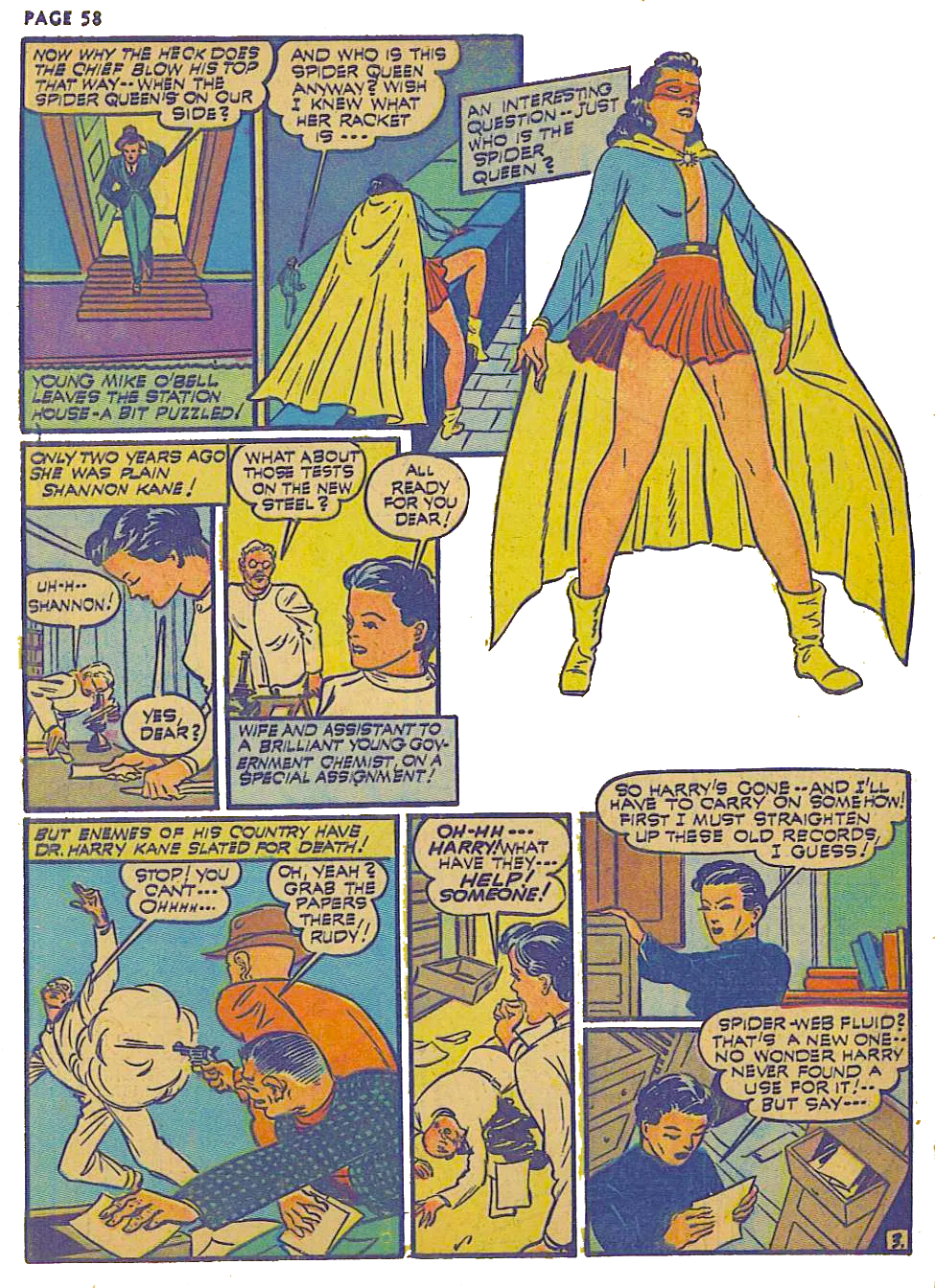
Use and abuse of Ultra-power
[Ultra-power], which permits the character to use a wide range of powers for 3 character points per rank, is open to abuse by players who care less about having fun than they do about “winning”. It’s important to stress that the powers in an [Ultra-power] should have a tightly unifying theme and should all derive from the same power source. If the [Ultra-power] is relatively low-powered, like Grimknight’s “investigator’s tools”, then the GM may want to turn a blind eye if the player plays a bit fast and loose with the “tightly unifying theme”. After all, there’s not much harm in allowing the player some latitude when the rank of the [Ultra-power] is only 1 or 2.
For a character whose main power is the [Ultra-power], enforcing the theme becomes more important. A character who can accomplish anything the player can think of can easily spoil a game and ruin everyone’s fun.
It’s also important to recognize that just because the [Ultra-power] is rank 6, for example, that doesn’t mean that every power in the [Ultra-power] necessarily has rank 6. For example, Miasma’s “grenade launcher” [Ultra-power] is truly formidable at rank 11, yet she has several grenades which are of far less rank than that. Her smoke grenade, for example, is only rank 2. The most important thing to consider when choosing the rank of a power in an [Ultra-power] is what makes sense for the character.
The theme and the rank of the [Ultra-power] are important limits on the character, but the most important limit should be what makes sense for the character’s background and abilities. A character should never have a power simply because the rules permit it. You control the game, not the rulebook.
While on the topic of [Ultra-power], here’s a question from a player on how to write-up [Ultra-power] in the Bulletproof Blues Character Sheet Helper.
I have some questions about the Bullet Proof character sheet helper spreadsheet. I am in the middle of creating a gadgeteer for a pulp hero game and was wondering about the Ultra Power on the sheet. How do group my gadgets under Ultra Power or do I not and just do them individually?
Logan
Hi, Logan!
The way [Ultra-power] works, it allows you to have any power that a) fits in the theme of the [Ultra-power], and b) has the rank of the [Ultra-power] (or less).
In the Character Sheet Helper, you buy the [Ultra-power] in the top powers section, and then, if you want, you can write up some frequently-used powers in the [Ultra-power] section in the bottom part of that screen. The powers listed in the [Ultra-power] section do not cost the character any points, and you are not limited to the powers you write up in the [Ultra-power] section — that list is just to make it easier for you and the GM during play. If you take a look at the Character Sheet Helper file for Miasma, she’s a pretty good example of how to write up a character with an [Ultra-power].
We hope this has been helpful.

